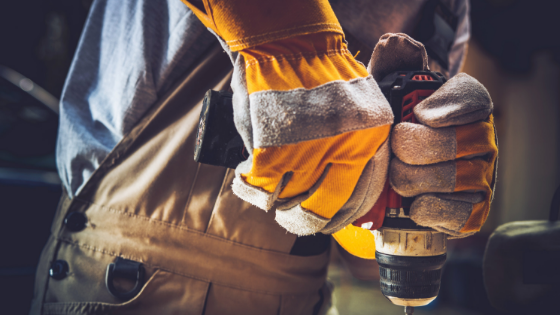According to OH&S, hand accidents account from between 40 to 60 percent of recordable workplace incidents. Selecting a pair of gloves to work goes beyond finding the right fit and form.
Different types of work safety gloves offer different types of hand protection. Rather than use a one-size-fits-all approach, there are certain gloves you’ll want to use for specific jobs. How can you tell if you’re using the right glove for your work? This guide covers 9 different types of work safety gloves and when they should be used.
What Type of Gloves Protects Your Hands from Hazardous Chemicals?
Choosing protective gloves is based on the specific hazards present:
- Nitrile gloves provide protection against a range of chemicals and infectious agents.
- Rubber gloves safeguard against mild corrosive materials.
- Neoprene gloves shield against solvents, oils, and mild corrosive materials.
Cotton/Fabric Gloves
This is the most common type of gloves for general work or projects where a high level of protection isn’t needed. These gloves offer a thin, lightweight fabric covering that offers little safety to the user. They’re mostly used to prevent minor scrapes or splinters, though do nothing to prevent punctures, burns, or cuts.
Coated Fabric Gloves
A step above non-coated fabric gloves, these gloves provide a little more protection against punctures, cuts, and chemicals. Nitrile, PVC, and polyurethane are common types of coatings, but the actual coating you need depends on the job itself.
Leather Gloves
Leather gloves are desirable for a number of reasons. They provide good grip, insulation, and durability. They’re thicker than regular fabric, which offers a higher level of protection.
However, leather gloves tend to dry, crack, or shrivel when excessively exposed to high temperatures. They’re not ideal for working with heat because of this reason, though they do offer adequate burn protection when in good condition.
Welders commonly use leather gloves, usually with a durable liner to offer extra protection.
Latex, Rubber or Plastic Gloves
These gloves are most commonly used in medical settings or laboratories. They’re usually form-fitting to allow for movability, but offer protection from biohazards, chemicals, solvents, and other harmful substances.
However, because the material is so thin and flexible, these gloves offer no puncture or heat resistance. They’re not ideal when using sharp tools or flames, or when working with abrasive surfaces.
Kevlar Gloves
The durability of kevlar gloves make them an ideal choice for industrial situations. The material offers a lightweight yet robust solution to hand protection, allowing for movability yet remaining strong under duress. Kevlar is resistant to cuts and punctures and is often used as a lining in other types of gloves.
Butyl Rubber Gloves
Butyl rubber gloves are the best solution when working with chemicals. Because they’re rubber, they don’t absorb liquids they come into contact with. The rubber resists harmful chemicals like alcohols, ketones, nitro-compounds, acids, bases, and even rocket fuel. They can withstand hot and cold temperatures, abrasion, oxidation, and ozone corrosion, as well.
Vibration-Resistant/Impact-Resistant Gloves
The impact of prolonged vibration is becoming a top concern to EHS leaders. Luckily, there are vibration-resistant gloves that can help to reduce the impact of extended vibration. These gloves help to absorb much of the impact of vibrating tools or equipment so that less energy is transferred to your hands. They are most commonly used in the fabrication, automotive, and construction industries where workers use vibrating tools for extended periods of time.
Puncture-Resistant Gloves
These gloves are specifically designed to resist cuts or punctures to the hand. The woven design helps to deflect sharp objects that could puncture the skin. Industries that perform manual cutting, such as construction, food service, and warehousing, can benefit from puncture-resistant gloves.
Aluminized Gloves
These are one of the best types of gloves to wear when working with heat. They’re extremely resistant to high temperatures, which is why they’re common in welding, foundries, and laboratories. They can protect your hands without fail at temperatures of up to 2,000ºF.
Choose the Right Type of Glove for the Job
Knowing the safety challenges a job entails can help you to choose the correct hand protection. Start by identifying hazards, then exploring your work safety glove options to find the best solution. Your hands are counting on you!
Want more health and safety insights? Head back to the EHS Insight blog for more industry news and best practices.
